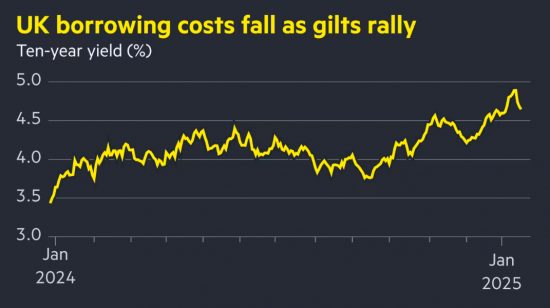A week on from the supposed gilt crisis the FT has produced this chart:

The rate of return on UK gilts has resulted in a rush of money into gilts. Their price has risen as a result. So, the interest rate has fallen. The price and interest return on gilts are always in an inverse relationship.
Three thoughts. First, those who took positions to support Musk, as I suggested they had, will have lost as a result.
Second, people are expecting the price to continue to rise, so the interest rate will fall further. The Bank of England needs to take note.
Third, there is no gilt crisis. People want them. It's time for those pretending otherwise to take note, and stop peddling nonsense.
Thanks for reading this post.
You can share this post on social media of your choice by clicking these icons:
There are links to this blog's glossary in the above post that explain technical terms used in it. Follow them for more explanations.
You can subscribe to this blog's daily email here.
And if you would like to support this blog you can, here:


 Buy me a coffee!
Buy me a coffee!

Thank you, Richard. Spot on… there is and was no crisis.
This is not to say that the BoE and Rachel Reeves are doing the right thing…. but idea that there was a crisis is nonsense.
Also, as you say, any short sellers have lost heavily…. and it is fear of losing money that keeps these folk in check. No need to ban it.
Noted
If as would appear to be true we are “led by donkeys” then the so called “gilts crisis” was really just a “donkey derby”!
https://www.collinsdictionary.com/dictionary/english/donkey-derby
https://www.thefunexperts.co.uk/roll-a-ball-donkey-derby-hire
Richard, on what basis do you claim that ‘people are expecting the price to continue to rise, so the interest rate will fall further’.?
Which people? What evidence is there for further yield reductions? The market price of gilts already reflects current expectations. What information do you have that the market does not?
Oh dear. You believe in rational expectations. I really can’t help you.
5 year OIS rate is 4.06% (see BoE website). This means that the market “expects” the Base Rate to average 4.06% over that period. Given that it is 4.75% today, this means that the market is pricing in Base Rate cuts.
I am so gilt-ee of knowing enough about this, I cannot comment.
Was it in the 90’s there was something of a Gilts shortage?
There were years when there were not repurchases under Brown
Yes, the auction of spectrum for mobile phones was raising such huge sums and the economy was booming delivering such large tax receipts that gilt issuance dropped hugely. Indeed, for a long period 30 year gilt rates were far below German 30 year rates.
Why do gilts share their name with a female pig that has not yet produced her first litter?
They were once printed on paper with a gold edge.
In finance, a gilt is a nominalized adjective.
In farming, a gilt is an unfarrowed sow
Government Bond markets are price takers NOT price makers. Why are governments so frightened of something they have complete control over.
If Bond yields rise, accompanied by price drops, The BoE can go into the market and threaten to buy unlimited quantities of Bonds, if yields go above the level the BoE wants the yield to be. It just has to threaten not necessarily buy. If a yield on a particular Bond is at 4.1% and the BoE wants it to be at 4.0%. The market will bring that yield back to 3.99%. I think the BoE has forgotten it has this tool. Likewise, why is it still paying interest on Banks “reserve” accounts.
Of course, you are right, government can control interest rates right across the yield curve… if it wants to. The problem is that the BoE WANTS rates up at this level – they believe it’s required to keep inflation at bay.
Clive, acorn I also think BoE as an organisation wants to retain interest rates as its prime monetary tool. QE almost trashed interest rates as a weapon for control. The BoE along with the Banks have worked hard to reinvigorate their weapon of choice. They have now achieved this so will be reluctant to see rates to fall to far. OBR report on the budget gives a clue to this by indicating that they see interest rates unlikely to fall below 3.5% out to 2029.